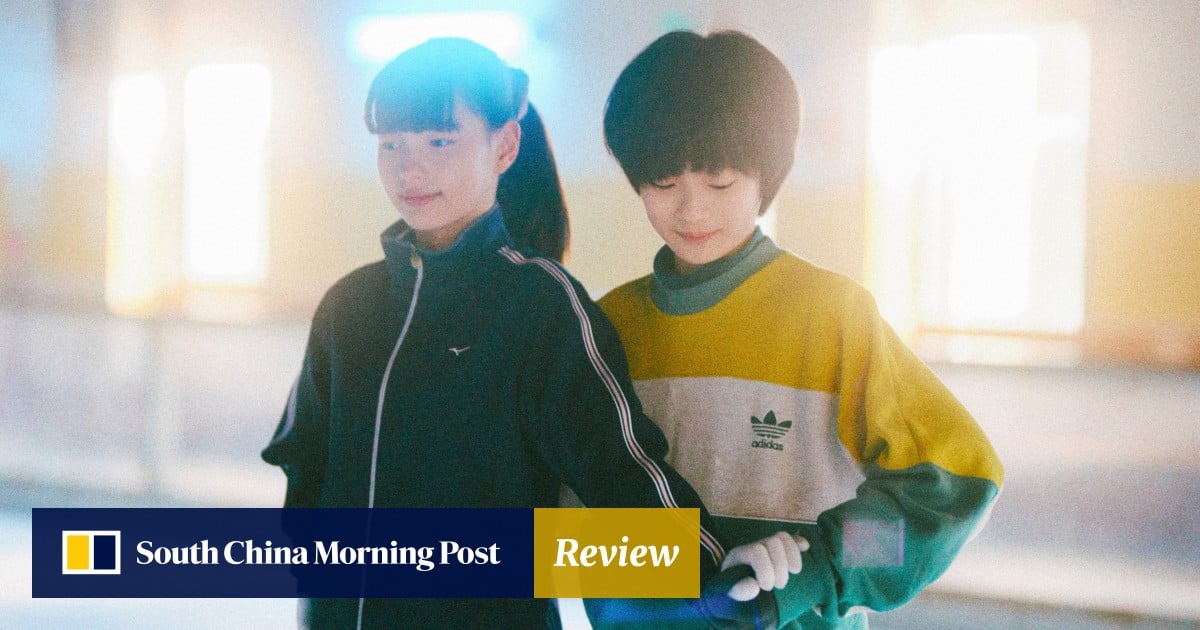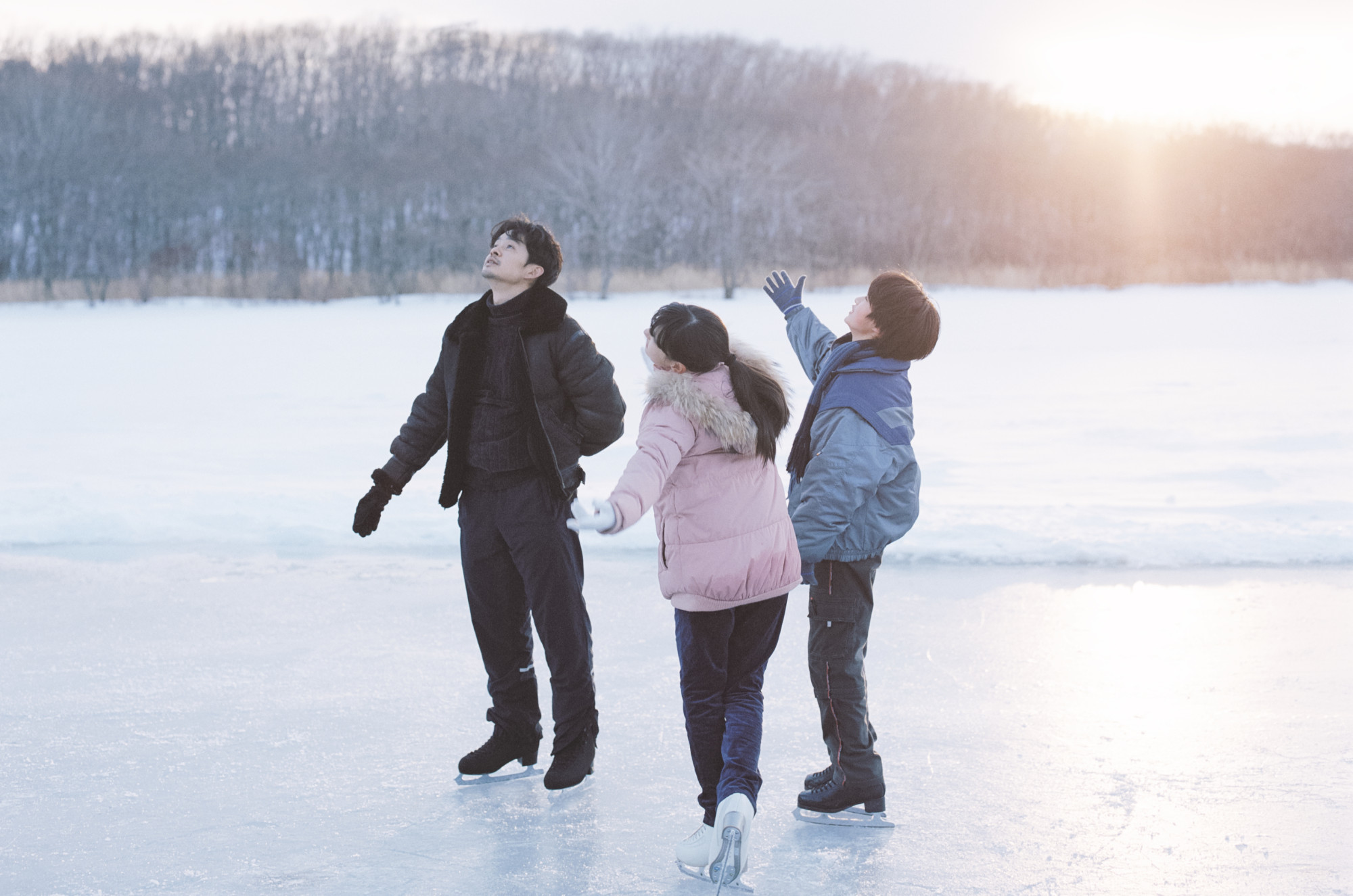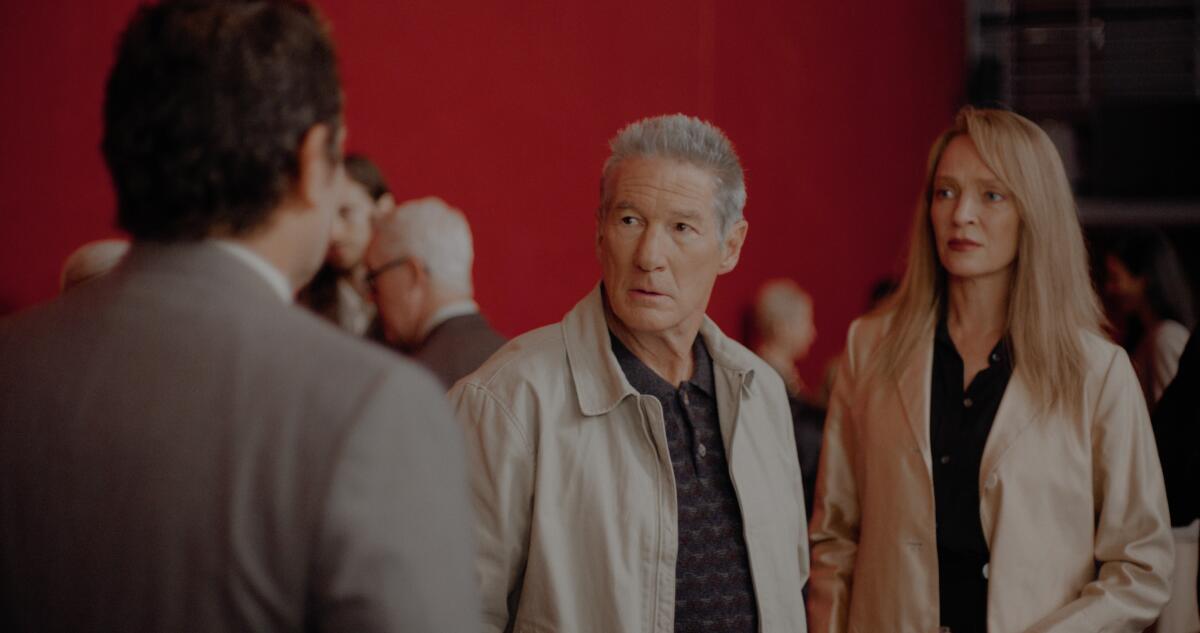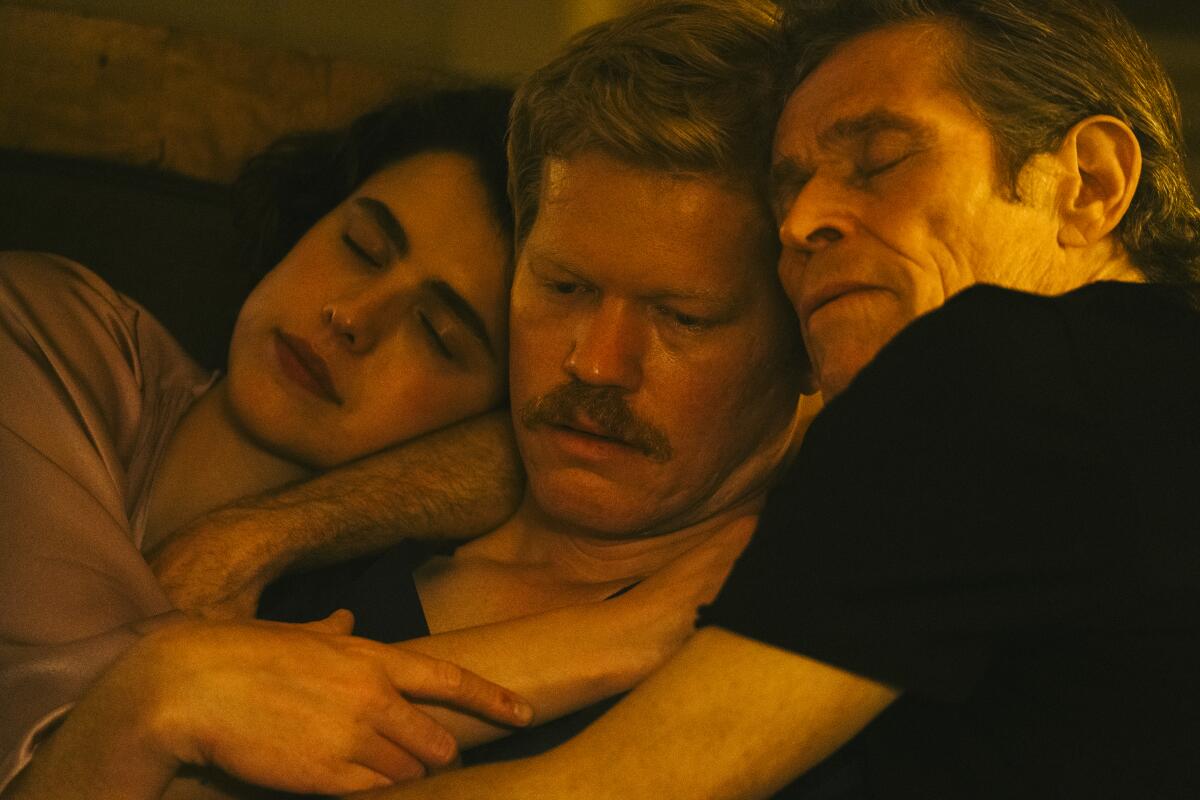Entertainment
Camila Mendes wants more films about the Brazilian American experience, so she produced one

Since booking her breakout role in The CW drama “Riverdale” in 2017, Camila Mendes has skyrocketed to fame as one the most prominent Brazilian American stars in Hollywood. Yet, despite building on her success with acclaimed projects such as Netflix’s “Do Revenge” and Hulu’s “Palm Springs,” the actor says she has yet to receive a single script calling for a Brazilian role. “I get asked to play everything under the sun, every different kind of Latina, except Brazilian,” she says.
That’s what drew her to her latest project, “Música,” a coming-of-age musical rom-com directed by and starring Rudy Mancuso that premiered this week at the South by Southwest Film and TV Festival. “Música” tells the story of Rudy, an aspiring artist trying to navigate his future as he’s pulled in different directions by his overbearing mother (Maria Mancuso), his girlfriend Haley (Francesca Reale) and his new crush, Isabella (Mendes). It’s a charming, unorthodox musical that doesn’t feature traditional musical numbers. Instead, drawing on Rudy’s synesthesia, the film bursts to life in sequences where the surrounding environment — a nearby basketball game, kids playing jump rope, a lively game of checkers at the park — all become part of a symphony.
Mendes was hesitant about the project at first — Mancuso was a first-time director, and he had initially risen to fame on YouTube and Vine. But, her reservations melted away when she spoke with Mancuso and learned how passionate he was about getting the film made, as well as his desire to expose more audiences to the Brazilian American experience. “Deep down, I think I always knew I was going to take the role,” she says. “How could I say no to this opportunity?”
The film’s on-screen love story evolved into a real one off-screen, with Mancuso and Mendes celebrating their one-year anniversary last July. “Música” will be available to stream on Prime Video on April 4.
“Música” is the second rom-com you’ve starred in and produced this year. Is that something you want to do more of?
The rom-com thing is completely coincidental. [Laughs] It’s funny, because I know that “Música” is technically a rom-com, but to me, it didn’t feel like any rom-com I’d seen before, so I never categorized it that way in my head.
When you hear “musical,” I’m sure a lot of people start imagining structured song and dance numbers, which is very different from what we see in “Música.” What convinced you to sign on?
Rudy’s team sent me the script with a kind of sizzle reel — basically a short version of the opening scene — just to give an example of the vision. It would say in the action “It breaks into a musical number with people banging on pots and pans,” but you don’t know what that actually looks like without an example. That got me excited, but also, I was skeptical. I didn’t know much about Rudy. I just knew that he was a Viner, so I had my own preconceived notions of what that meant, and I was also just in my head about my career choices at the time. But I decided to meet with him because I wanted to meet a fellow Brazilian in the industry, and he was obviously very talented. When I met with him, I was floored. I knew I needed to work with him, but I also knew I had to produce this. It was the only way I would sign on, because I had notes about my character, Isabella.
What stood out to you that you wanted to change?
Well, I really wanted to develop not just my character, but the other female role, Haley. I wanted to make sure they felt fully realized and complete. Rudy was like, “Absolutely, that’s part of the reason we want you on board.” So over the course of a few months, I would Zoom with him to work on scenes and dialogue and make sure, especially for Haley’s role, that she wasn’t just the rich white girl, that we weren’t making their dynamic so binary. Then obviously, we personalized my role and gave her a little bit more of a backstory.
Why was creating that backstory important to you?
With love stories, you really need to understand the conflict. What is it about Isabella that interests him, and what is it about him that triggers Isabella? I wanted her to be authentic, so what ended up happening was that I brought some of my own struggles to the role in order to kind of find her as a character.
Beyond you and Isabella sharing the same Brazilian American background, what were some of those personal elements that bled into the character?
I mean, it’s exaggerated and not necessarily a mirror of what my upbringing was like, but a little bit of her backstory. I can say this now because we’ve talked about it and we have a great relationship, but when I was finishing up high school, my mother moved back to Brazil to live with a guy she was seeing. My parents were divorced and I went to move in with my dad. During that time, I remember having gone through my first heartbreak as a kid and really wishing my mother was there. I remember as a teenager that absence and that feeling of abandonment. I thought that was a good thing to incorporate into Isabella’s character because you have Rudy’s character who’s so annoyed by his mother’s love and overwhelmed with how involved she is in his life. I think it’s nice to have a character like Isabella who’s like, “Actually, I wish my mom was more involved in my life.” I just took that one little thing from way back in the day and kind of pulled from that so that I had an avenue into her character and her pain.
How did it impact you finally getting to play a character who spoke to some of your experiences?
I think story-wise, the emphasis on family in Brazilian culture is something that I’ve really grown to embrace more. Especially now dating a Brazilian, it’s opened me up to that perspective of really putting more of an effort and to stay close to family to see them more. Obviously, being in Hollywood for so long, you can get so career focused and make everything about success. But the older you get, the more you realize that’s really not what matters. I want to be able to look back on my life and feel like I created strong relationships with the people that I love. And I think this movie has a really strong message with that.
This is the second project out this year that you’ve worked on as an actor and a producer, what motivated you to step into that role?
I think producing for me was a way to make sure that I was protected. Especially coming from a teen show, I’m so cautious with who I work with and I want to make sure that they’re going to represent me well. That’s a big fear that I have, because when you’re on a show, you work with a new director every episode and you have very little control of the outcome. You might watch an episode and see that they cut it in a certain way and now you look like a bad actor. You feel like you’re being misrepresented. So for me, my avenue into producing was trying to take control and having creative authority and protecting myself. That’s evolved to be a deeper passion and love for the art of producing as a whole but that’s definitely how it started.
As a producer, you have a whole new layer of interest vested into this story than you did as an actor. What do you hope people take away from their experience watching “Música?”
From a personal standpoint, I’m very excited for people to see what Rudy is capable of. I know that there’s such a stigma around being an internet personality and having your talent undermined. So I’m just so excited for people to see just how creative and visionary he is.
But I’m also excited for people to get a glance into Brazilian culture, because there’s truly no movies representing Brazilian culture right now. And there’s something even more nuanced about “Música” in the sense that it’s Brazilian American, which I think is accessible to a lot of children of immigrants. You don’t have to just be Brazilian to relate to the story. Anybody who feels the duality of being an immigrant child, having one culture passed down to them but living an entirely different one, knows that clash of ideologies can be so difficult to navigate. Seeing Rudy navigate those dualities was refreshing because I’m navigating the same one. It’s been really great to have somebody who understands my experience, so I hope that there are people watching this movie that will also relate and feel seen.
Was part of your motivation for getting into producing wanting to expand Brazilian representation in the industry?
Oh, absolutely. I just don’t think there are enough people behind the camera creating that platform, so I just feel very lucky that I get to be part of the beginning of it. I kept telling Rudy, Brazilians need to have their “Crazy Rich Asians” moment, where resilience can finally feel seen.
How do you hope “Música” plays a role in expanding people’s awareness of Brazilian culture and the Brazilian American experience?
On a very, very microscopic level, I think it would be great if it helped people learn that Brazilians speak Portuguese. [Laughs] That would be a big win for us. But also, Brazilian culture is so beautiful, and it’s never showcased in a romantic way. I think a lot of people’s exposure to Brazil in film is like “City of God”-type violence. That is part of the Brazilian story, but it’s just one aspect. There’s this whole other side to it that isn’t really celebrated in film. I’m excited for people to hopefully recognize that.

Movie Reviews
My Sunshine: Jesus director returns with poetic ice-dancing drama

4/5 stars
Rarely has figure skating been shown as so pure, poetic and sensual than in My Sunshine, Hiroshi Okuyama’s feature about two young ice dancers and their coach over one winter in a small town in Hokkaido, in Japan.
Filmed in the classic four-by-three screen ratio and boasting a desaturated colour palette which gives everything a dreamy quality, My Sunshine revolves around Takuya (Keitatsu Koshiyama), a stammering boy who is as awkward at sport as he is with his speech.
Bad at school in both baseball and ice hockey, the boy finds himself captivated by figure skating – or, specifically, the elegant star skater Sakura (Kiara Nakanishi). His perseverance in trying out pirouettes is noted by the girl’s coach Arakawa (Sosuke Ikematsu), who gives the boy proper skates and then private lessons.
Sensing a prodigy in the waiting, Arakawa begins to train Takuya alongside Sakura to compete in a pairs skating competition. Through this, the man rediscovers the joie de vivre he seems to have left behind after his retirement and relocation to the rural hinterlands.
Teasing natural and dynamic turns from his cast – with Sosuke looking very much the part with his smooth moves on the ice – Okuyama delivers scenes that ooze youthful energy and human warmth.
In the film’s pièce de resistance, a scene depicting Takuya and Sakura’s full routine, the duo glide gracefully across the ice, their breathing and the crisp glissando produced by their skates saying much more about their emotions than words ever could, whether about their dedication to the sport or the unarticulated feelings bubbling within each of them.

But My Sunshine is not all sweetness and light. Its descent towards tragedy is perhaps prefigured by Okuyama’s frequent positioning of his characters as small dots in vast spaces – an allusion, perhaps, to how their fates are somehow shaped by unspoken social forces they could not control.
And it is exactly such tacit norms which will eventually snap the trio’s growing bond.
Eschewing melodrama, Okuyama simply hints at the prevalent conservative attitudes in the town, the disapproval of Arakawa’s private life never really breaking into the open beyond one single word Sakura throws at her erstwhile mentor.
It is an altercation that is as brief as it is heartbreaking, and it speaks volumes about Okuyama’s deftness in evoking such emotions through his very economical storytelling and stylistic rigour.
Entertainment
At a Cannes Film Festival of big swings and faceplants, real life takes a back seat

“Is it too real for ya?” snarls the Gang of Four-soundalike punk band Fontaines D.C. over a thrumming bass line on the soundtrack to “Bird” as we cruise the streets of Gravesend, Kent, east of London. How’s this for too real? Piloting an e-scooter is the shirtless, much-tatted Bug, played by Barry Keoghan, last seen in “Saltburn” wearing significantly less. Hanging onto him is 12-year-old Bailey (Nykiya Adams), his daughter from a previous relationship (something of a stretch, age-wise, but sure).
Ever the optimist, Bug is planning to sell the hallucinogenic slime he skims off the back of a toad he’s imported from Colorado to fund his imminent wedding to a fling of three months. And despite having an elaborate, curling centipede inked on his face and neck, he’s crestfallen that Bailey would let a friend cut off her locks before the big day. She’s entering surly adolescence like a hot comet and not thrilled to have a new stepmother.
It’s all in keeping with the studied miserablism of British director and Cannes darling Andrea Arnold (“American Honey”). Every interior in “Bird” is more squalid than the last; every door seems designed to be busted down by a violent boyfriend.
Nykiya Adams in the movie “Bird.”
(Atsushi Nishijima)
Is it too real for ya?
Actually, no, not really. And that’s before Arnold introduces us to Bailey’s creepy Boo Radley-ish friend, the mysterious title character (Franz Rogowski of “Passages,” deepening his brand of bug-eyed strangeness), who, in a long-telegraphed moment of protective vengeance, sprouts huge CGI wings that were already painfully suggested.
“Bird” is part of what might be described as Cannes’ reality problem. Or so it seems — it’s only the halfway mark — as we ping-pong between screenings of revered directors leaping off the deep end, their former penchants for verisimilitude tossed aside. Emerging from the raves for George Miller’s “Furiosa: A Mad Max Saga” came the admission, shared by many, that it just wasn’t convincing physically: too lacquered and digitally finessed, the grungy tactility of “The Road Warrior” long gone. Any hope of Francis Ford Coppola reproducing the warmth of his best films was dashed by the sprawling “Megalopolis,” a Rome-as-New-York urban fantasia that, for all its delightful looniness, could have used some subway grit.
Maybe realness is overrated. It’s tempting (but too easy) to impose a coordinated aesthetic on any one edition of a film festival, the early responders hoping to collate their scattered experience of seeing multiple movies a day into a larger sense of coherence. Still, this was restless work. Many of Cannes’ first-week offerings felt like products of the pandemic and, as such, exuded an air of desperation.

Richard Gere and Uma Thurman in the movie “Oh, Canada.”
(Festival de Cannes)
Paul Schrader’s flashback-heavy “Oh, Canada” — sluggish even at 95 minutes — is expressly about notions of reputational realness unraveling. A Hollywood lion in a fascinating winter, the always-watchable Richard Gere plays Leonard Fife, a celebrated Errol Morris-like lefty documentarian, who, though suffering through the final stages of cancer, agrees to a filmed interrogation by some of his most devoted students. Already you anticipate that some of these interviews aren’t going to go Leonard’s way as Schrader’s métier, the language of self-excoriating doubt, finds voice.
Was he a draft dodger who fled to Canada on principle to escape military service? Was he a faithful family man? No points for guessing correctly on those two. Meanwhile, a deeper truth emerges, more about the inexorable march of time than integrity. Gere, reuniting with Schrader for their first collaboration since the exuberant strut of 1980’s “American Gigolo,” is a fragile, vulnerable presence here, playing up Leonard’s thickened voice and dimmed virility. “I have a Genie and a Gemini!” he sputters, clinging to his awards while the rest of his life tips into fabrication.
Please, Yorgos Lanthimos, show us how it’s done: If we’re going to have a Cannes overrun with fantasy, let one come from the maker of “Poor Things” and “The Lobster.” The Greek director has chosen an unfortunate moment to do a faceplant. “Kinds of Kindness,” though it gets its audience pumped with opening credits set to Eurythmics’ snaky, pounding “Sweet Dreams (Are Made of This),” slackens into a tiresome trio of subpar mini-films lacking the emotive weirdness that Lanthimos usually serves on tap.

From left, Margaret Qualley, Jesse Plemons and Willem Dafoe in the movie “Kinds of Kindness.”
(Atsushi Nishijima / Searchlight Pictures)
It’s not the actors’ fault, many of whom take on triple duty in three brittle, gruesome tales about, sequentially, murderous micromanagement, cannibalistic survival and obsessive cultdom. The cast launches gamely into the flat-toned violence: Jesse Plemons, Emma Stone, Willem Dafoe, Hong Chau and a particularly committed Margaret Qualley (who hopefully filed for worker’s comp). The weak link, however, is the script by Lanthimos and Efthimis Filippou, who, despite the hope they’d steer back to their darkly suggestive “Dogtooth” days, can’t seem to link their customary meanness to any kind of profundity.
Lanthimos has never made a movie this gratuitously brutal (brace for a fried thumb served on a dinner plate), nor has he made one this dumbly obvious, relying on that ominous, pinging piano note from “Eyes Wide Shut” and a frisky cast to sock it over. He’s clearing his throat. It’s more a collection of memes than a sustained piece of thinking.
One filmmaker, though, has nailed the free-floating dreaminess that Cannes seems to be lost in, the Zambia-born Rungano Nyoni, whose confidence summoning a mood clarifies in the exquisitely haunting “On Becoming a Guinea Fowl.” (Playing in the Un Certain Regard section, her drama runs circles around several others in the official competition.) It begins in the middle of the night — a sequence you’ll never want to end — as Shula (Susan Chardy), driving home from a party, pulls over. There’s a dead body on the road. Turns out it’s her uncle Fred. A garrulous, drunk cousin, Nsansa (Elizabeth Chisela), shows up, lending her some unwanted company.
The movie then eases into the rituals of mourning: mounting a funeral, cooking for the bereaved, grieving performatively, so much of it conducted in a state of shock. Nyoni’s debut, the surreal 2017 comic satire “I Am Not a Witch,” poked a sharp stick in the eye of African mysticism, drafting a solemn girl into unwanted witchery while other women remained tethered to traditional roles. Here, the connection is cooler and more disturbing. As Shula steps into rooms flooded with water, the film pivots to a trance-like menace, echoed by Lucrecia Dalt’s scraping experimental synth score.
We also learn more about guinea fowl than ever imagined, including how the plump species warns the rest of the herd of danger. Shula, lost in her stubbornly vague half-memories, can’t quite shake free of her uncle’s past. And when a final showdown arrives — several women and girls chirping out an animalistic warning — the hair on the back of your neck pricks up.
Suddenly, Cannes was too real after all.
Movie Reviews
‘The Substance’ Review: An Excellent Demi Moore Helps Sustain Coralie Fargeat’s Stylish but Redundant Body Horror

Not long into Coralie Fargeat’s campy body horror The Substance, Elisabeth Sparkle (Demi Moore) is unceremoniously fired from her gig as the celebrity host of a daytime exercise program. The former actress’ credentials — an Academy Award, a prominent place on the Hollywood Walk of Fame — aren’t enough to save her Zumba-meets-Jillian-Michaels-style show, fittingly called Sparkle Your Life. Her producer, an oily personality conspicuously named Harvey (Dennis Quaid), wants to replace Elisabeth with a younger, more beautiful star. In his words: “This is network TV, not charity.”
The Substance, which premiered at Cannes in competition, is Fargeat’s second feature. It builds on the director’s interest in the disposability of women in a sexist society, a theme she first explored in her hyper-stylized and gory 2017 thriller Revenge. She gave that film a subversive feminist bent by turning the trophy girlfriend — a sunny blonde who is raped and murdered — into a vengeance-seeking hunter.
The Substance
The Bottom Line Uneven genre offering boosted by formal ambition and Demi Moore.
Venue: Cannes Film Festival (Competition)
Cast: Demi Moore, Dennis Quaid, Margaret Qualley
Director-screenwriter: Coralie Fargeat
2 hours 20 minutes
In The Substance, a woman also takes fate into her own hands and combats underestimation, only this time she’s at war with herself, too. Fargeat combines sci-fi elements (as in her early short Reality+) with body horror and satire to show how women are trapped by the dual forces of sexism and ageism. Beauty and youth are the targets at the heart of this film, but the director also takes aim at Hollywood’s ghoulish machinations and the compulsive physical and psychological intrusiveness of cisgender heterosexual men.
Fargeat flaunts an exciting hyperactive style. Ultra wide-angle shots, close-ups and a bubble-gum color palette contribute to the film’s surreal — and at times uncanny — visual language. The British composer Raffertie’s thunderous score adds an appropriately ominous touch, especially during moments of corporeal mutilation.
There’s a lot going on in The Substance, and while the ambition is admirable, not everything works. The thin plotting strains under the weight of its 2 hour 20 minute runtime; there are scenes, especially in the middle of the film, that land as leaden repetition instead of clever mirroring. But strong performances — especially from Moore and Quaid — help sustain momentum through the film’s triumphantly amusing end.
During his final meeting with Elisabeth, Harvey doubles down on his offensiveness. By the time women reach the age of 50, he suggests to Elisabeth while stuffing his mouth with shrimp, it’s over for them. Fargeat heightens the perversity of Harvey’s blunt assessment with shots of his mouth masticating on shellfish bits. As he crushes the coral-colored creatures with his molars, Elisabeth stares at him with a faint disgust bordering on hatred. Quaid’s character lives in the more satirical notes of The Substance, and the actor responds with an appropriately mocking performance.
Harvey’s words, coupled with the blank stares Elisabeth now receives from passersby, drive the actress to seek a solution. She reaches out to the anonymous purveyors of The Substance, a program that allows people to essentially clone a younger version of themselves. While Fargeat’s screenplay leaves much to be desired when it comes to conveying the company’s scale of operations or how they function in her version of Los Angeles, the rules of the experiment are straightforward. After individuals spawn their duplicates, it’s critical they maintain a balanced life. Every 7 days one of them enters a coma, kept alive through a feeding tube, while the other roams free. Then they switch. The catch, of course, is the addiction of youth.
Elisabeth and her younger self (Margaret Qualley), Sue, follow the program rules for a bit. The middle of The Substance is packed with scenes underscoring the difference in treatment they receive. While Sue blossoms, winning the affection of Harvey and getting her own exercise show, Elisabeth languishes in the shadow of her invisibility.
Moore imbues her character with a visceral desperation, one that enriches the unsettling undercurrents of Fargeat’s film. She plays a woman who can’t quit the addiction of having youth at her fingertips despite its lacerating effect on her psyche. In one particularly strong scene, Elisabeth, haunted by a giant billboard of Sue outside her window, struggles to leave the house for a date. She tirelessly redoes her makeup and each attempt reveals the layers of anguish behind the actress’s pristine facade.
Moore leans into the physical requirements of her role later in the film. Elisabeth eventually learns that upsetting the balance of the experiment reduces her vitality. Sue, greedier for more time outside the coma, becomes a kind of vampire, and Elisabeth wilts. Moore’s slow walk and hunched shoulders add to the sense of her character’s suffering. Special makeup effects by Pierre-Olivier Persin render Elisabeth’s withering even more startling and persuasive.
Qualley does not have as meaty a role as Moore. Her character functions as Elisabeth’s foil, seeming to exist only to help us understand the perversion of Hollywood’s gaze on the starlet. That’s a shame, because The Substance’s smart premise and direction promise more revelatory confrontations between Elisabeth and Sue than the one we are offered.
The reality of this experiment is that it traps both characters in the same toxic, self-hating cycle as the standards imposed by society. The most compelling parts of The Substance deal with how social conventions turn women against themselves. A stronger version of the film might have dug into the complexities of that truth, instead of simply arranging itself around it.
-

 News1 week ago
News1 week agoSkeletal remains found almost 40 years ago identified as woman who disappeared in 1968
-

 World1 week ago
World1 week agoIndia Lok Sabha election 2024 Phase 4: Who votes and what’s at stake?
-

 Politics1 week ago
Politics1 week agoTales from the trail: The blue states Trump eyes to turn red in November
-

 World1 week ago
World1 week agoBorrell: Spain, Ireland and others could recognise Palestine on 21 May
-

 World1 week ago
World1 week agoCatalans vote in crucial regional election for the separatist movement
-

 Movie Reviews1 week ago
Movie Reviews1 week ago“Kingdom of the Planet of the Apes”: Disney's New Kingdom is Far From Magical (Movie Review)
-

 Politics1 week ago
Politics1 week agoNorth Dakota gov, former presidential candidate Doug Burgum front and center at Trump New Jersey rally
-

 World1 week ago
World1 week agoUkraine’s military chief admits ‘difficult situation’ in Kharkiv region














